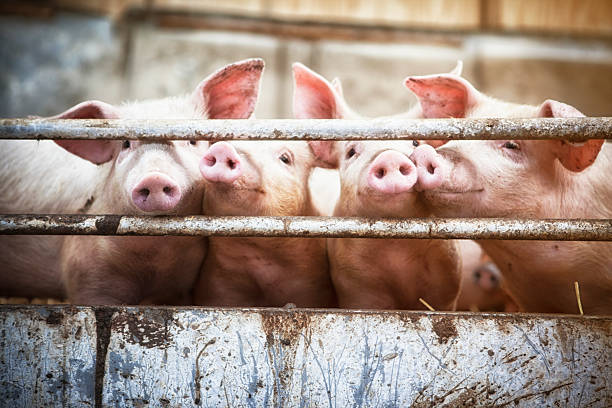Search
Featured post
Most common diseases in pig farming
Most common diseases in pig farming
Pig farming, a crucial segment of the global agriculture sector, faces numerous challenges, particularly when it comes to the health of its livestock. Understanding the most common diseases that affect pigs is imperative for farmers, veterinarians, and stakeholders in the industry to ensure optimal productivity and welfare of the animals. This blog post outlines some of the prevalent diseases in pig farming, their causes, symptoms, and potential management strategies.
1. Porcine Reproductive and Respiratory Syndrome (PRRS)
PRRS is one of the most economically devastating diseases affecting swine worldwide. It is caused by a virus that primarily impacts the respiratory system and reproductive performance of infected pigs. Symptoms in sows may include reproductive failure, such as increased rates of stillbirths and mummified fetuses, while growing pigs often show signs of respiratory distress, such as coughing, nasal discharge, and lethargy.
Management of PRRS requires an integrated approach, including vaccination, biosecurity measures, and herd management practices aimed at reducing stress and improving overall animal health.
2. Swine Influenza Virus (SIV)
Swine influenza, commonly known as pig flu, is caused by influenza viruses that affects pigs. The clinical signs often mimic those of PRRS, with affected animals displaying symptoms such as coughing, fever, and reduced appetite. Secondary bacterial infections can complicate the situation, leading to pneumonia.
Preventative strategies include vaccination, maintaining a clean environment, and minimizing stress in pigs through proper handling and management practices. Farmers must also establish biosecurity protocols to limit exposure to the virus.
3. African Swine Fever (ASF)
African swine fever is a highly contagious viral disease that primarily affects domestic and wild pigs. The mortality rate for ASF can be extremely high, often reaching up to 100%. Symptoms include high fever, loss of appetite, and skin lesions. Troublesome for the industry, ASF poses significant economic risks due to trade restrictions and culling measures.
Management of ASF is particularly challenging as there is currently no vaccine available. Strict biosecurity measures, surveillance, and prompt reporting of outbreaks remain the cornerstones of managing this disease.
4. Swine Erysipelas (SE)
Swine erysipelas is an infectious disease caused by the bacterium Erysipelothrix rhusiopathiae, primarily affecting pigs. Characterized by symptoms such as fever, lethargy, skin lesions, and in severe cases, acute septicemia, the disease poses significant economic risks to the swine industry. Transmission occurs through direct contact with infected animals or environmental contamination. Effective management relies on vaccination, strict biosecurity measures, and prompt treatment to mitigate outbreaks. Understanding swine erysipelas is crucial for maintaining herd health and ensuring economic stability within the pork production sector.
5. Actinobacillus Pleuropneumonia (APP)
This bacterial disease is caused by Actinobacillus pleuropneumonia and is known to cause severe respiratory disease in pigs, especially in weanlings and growing pigs. Symptoms include sudden death, respiratory distress, coughing, and high fever. The disease can spread quickly in a herd and lead to significant economic losses.
Control measures focus on vaccination, enhanced sanitation, and proper ventilation within barns to minimize the spread of the bacteria. Regular veterinary consultations can help in developing a tailored vaccination strategy for the herd.
4. Parasitic GastroEnteritis (PGE)
Among the most common parasitic agents responsible for gastroenteritis in pigs are Trichuris suis, Ascaris suum, and Cystoisospora spp. These parasites can cause a range of symptoms, including diarrhea, weight loss, dehydration, and, in severe cases, mortality. The prevalence of these parasites is often linked to inadequate sanitation practices, overcrowded living conditions, and poor management strategies in swine production systems.
Diagnosis of parasitic gastroenteritis typically involves clinical examination and laboratory tests, including fecal analysis to identify eggs or cysts. Effective management and control strategies are crucial for mitigating the impact of these parasites. These may include improving sanitation, implementing rotational grazing practices, and utilizing anthelmintic treatments to reduce parasite loads. Furthermore, regular health monitoring and education of farm personnel play pivotal roles in maintaining pig health and preventing outbreaks of parasitic infections.
Conclusion
Effective pig farming hinges on understanding and managing the various diseases that can impact swine health. Awareness of common diseases such as PRRS, SIV, ASF, PEDV, and APP equips farmers to implement appropriate biosecurity measures and management practices that promote animal health and welfare. Staying informed through continuing education and collaboration with veterinary professionals is essential for preventing outbreaks and ensuring the sustainability of pig farming operations. As the industry evolves, continuous research into disease management will play a pivotal role in enhancing productivity and profitability in pig farming.
Search on Wikipedia
Labels
Most Popular
Tags
- animal health
- antibiotic abuse
- Antimicrobial resistance
- antimicrobial stewardship
- Brooding
- cat
- cat myths
- chicken
- cow
- dairy
- deworming
- dog
- dog care
- dog ethics
- dog grooming
- dog health
- Dog safety
- Dog training
- Dogs
- dress
- exercise
- exertional rhabdomyolysis
- Food safety
- hoof care
- hoof trimming
- Horse
- horse care
- horse disease
- Meat inspection
- Meat safety
- milking
- myths
- parvovirus
- pet
- pet care
- pet care.
- pet health
- Pig farming
- Pigs
- Poultry
- poultry farming
- poultry feed
- tick infestation



0 Comments